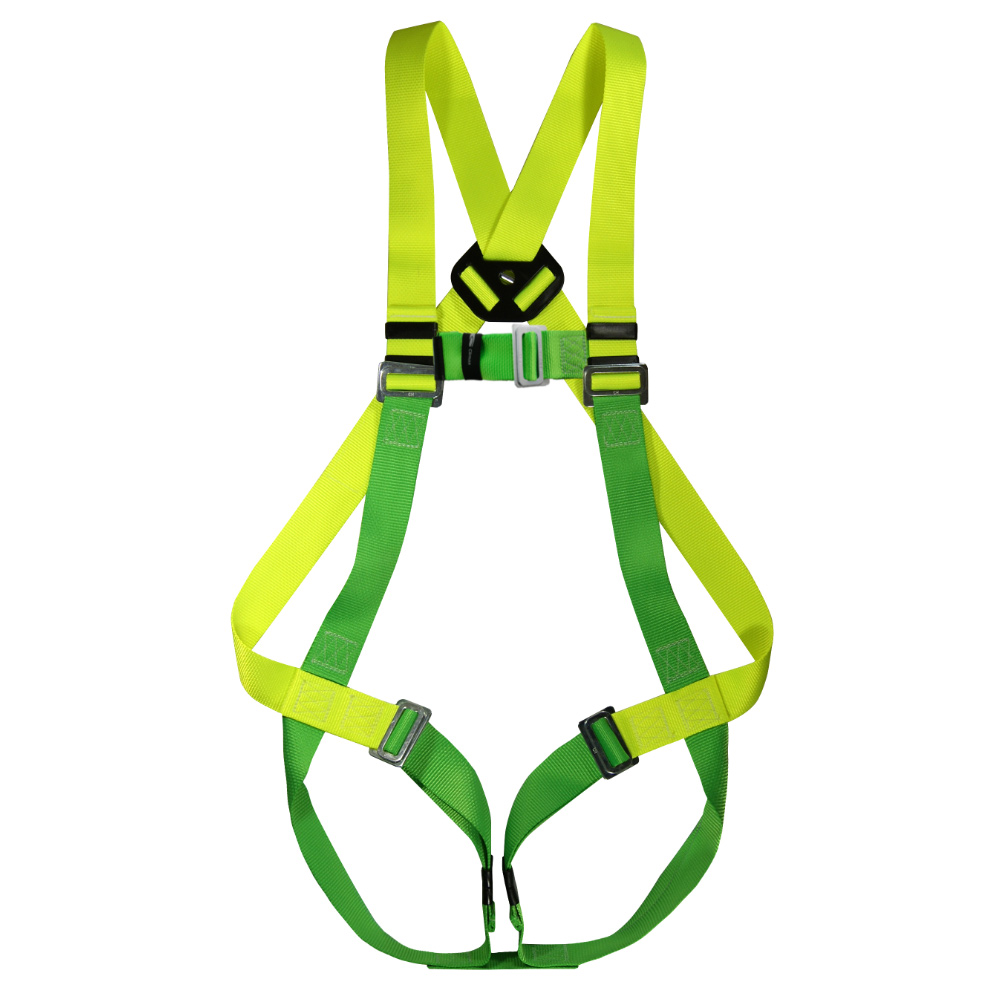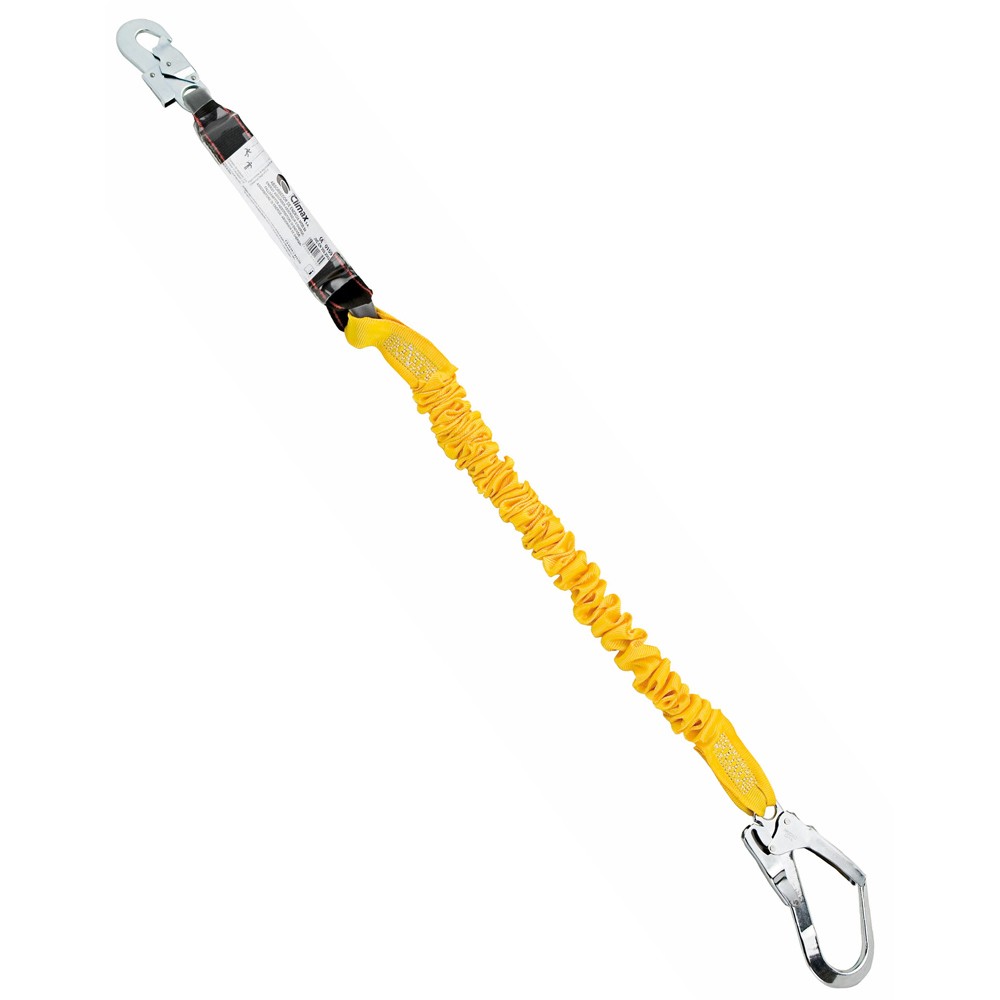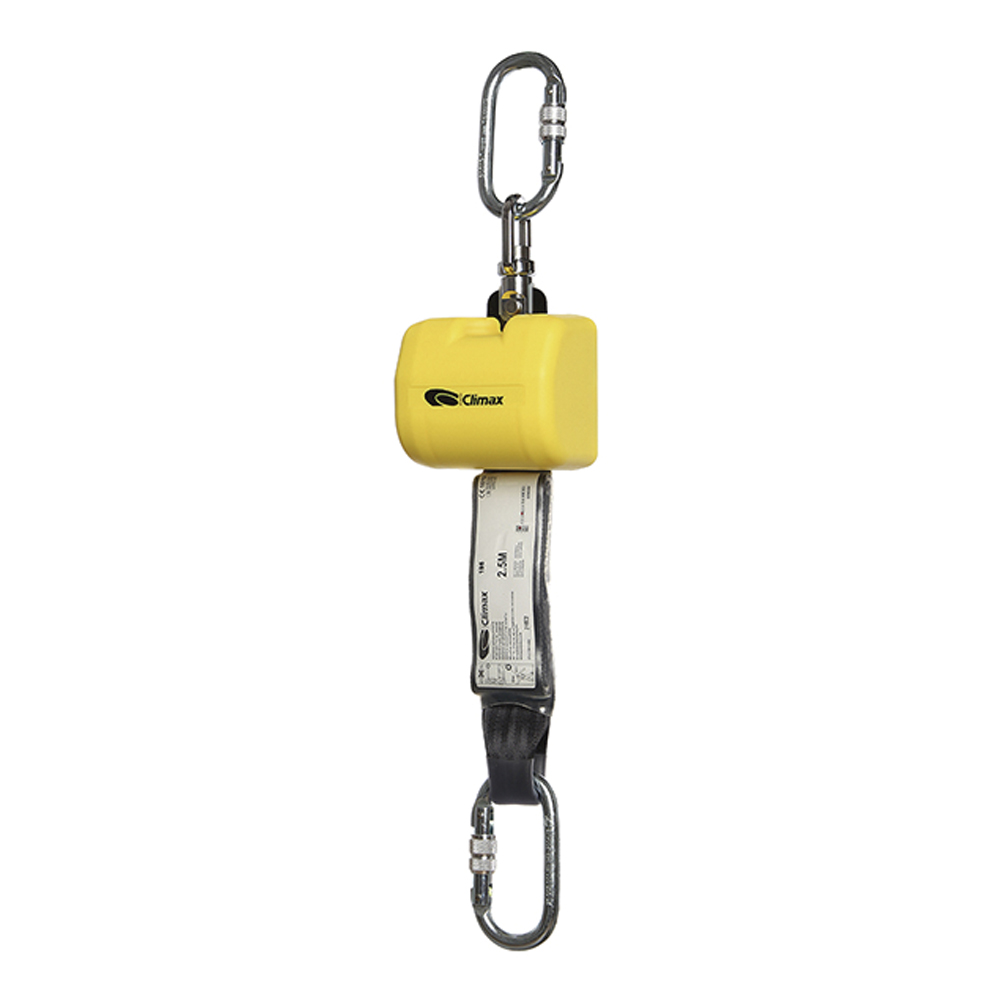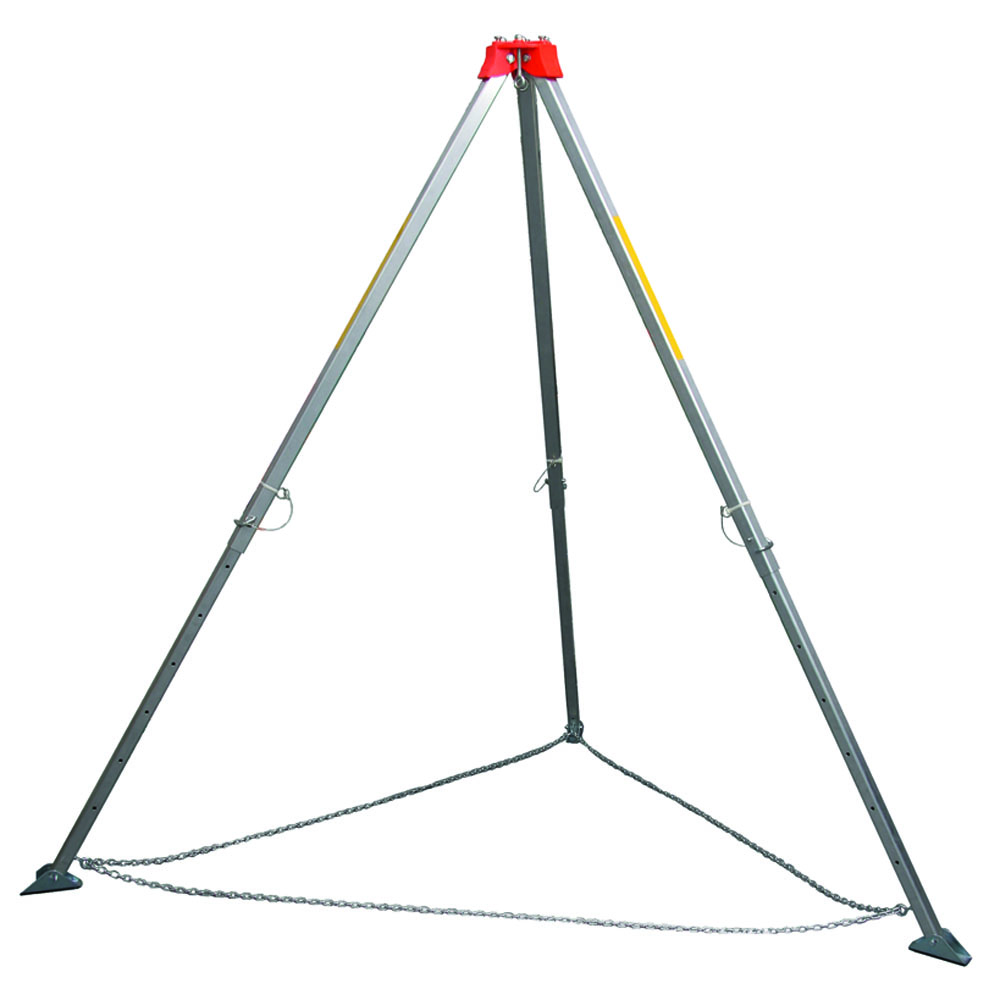Work-at-Height Safety: Harnesses, Lanyards, and More

Work-at-height safety equipment is essential for mitigating the significant risks associated with working at elevated levels, making it crucial to prioritise safety at every step. Falls from height are one of the leading causes of workplace injuries and fatalities, highlighting the critical importance of using the right safety equipment.
Whether you’re working on a construction site, in a warehouse, or performing maintenance tasks, having the appropriate gear is not just a regulatory requirement—it’s a vital part of protecting lives.
This article will explore the key components of work-at-height safety equipment, including harnesses, lanyards, lifelines and tripods. Each piece of equipment plays a crucial role in preventing falls and ensuring that workers can perform their tasks safely and efficiently.
By understanding the different types of equipment available and how to use them correctly, you can create a safer working environment for yourself and your team.
Understanding the Risks of Working at Height
Working at height inherently involves numerous risks, making it one of the most hazardous activities in any industry. The potential for serious injury or fatality is significantly higher when proper precautions are not taken. Understanding these risks is the first step in mitigating them and ensuring the safety of all workers involved.
Common Hazards Associated with Working at Height
- Falls: The most obvious and significant risk when working at height is falling. Even a fall from a relatively low height can result in severe injuries, including fractures, head trauma, or even death. Falls often occur due to unstable surfaces, poor weather conditions, or human error.
- Falling Objects: Tools, materials, or debris falling from height can pose serious risks to those working below. Even small objects can cause significant harm when dropped from a height, making it essential to secure all equipment and materials properly.
- Structural Failures: Working on ladders, scaffolding, or other temporary structures can be dangerous if those structures are not properly erected or maintained. Structural failures can lead to sudden falls, trapping workers, or other serious accidents.
- Environmental Factors: Weather conditions, such as wind, rain, or ice, can greatly increase the risks associated with working at height. Poor visibility, slippery surfaces, and high winds can all contribute to accidents if not properly managed.
The Consequences of Falls and How Proper Equipment Can Prevent Them
The consequences of a fall from height can be life-altering. Beyond the immediate physical injuries, such incidents can lead to long-term disabilities, psychological trauma, and significant financial costs for both the injured worker and the employer. However, the vast majority of these incidents are preventable with the right work at height safety equipment.
- Harnesses and Lanyards: Properly used, these can arrest a fall before the worker hits the ground, reducing the severity of any injuries. Full-body harnesses distribute the force of a fall across the body, while lanyards connect the harness to a secure anchor point.
- Lifelines: These systems provide continuous protection for workers moving horizontally or vertically at height. Lifelines, whether temporary or permanent, ensure that workers are always connected to a secure point, preventing falls from occurring.
- Tripods and Rescue Systems: In situations where workers must enter confined spaces or work in areas with limited access, tripods and other rescue equipment are essential. These devices not only help prevent falls but also provide a means for quick and safe rescue if an incident does occur.
By recognising the risks and understanding the role of proper equipment, you can significantly reduce the likelihood of accidents when working at height. Safety should always be the top priority, and investing in the right equipment is a crucial step in protecting workers and maintaining a safe work environment.
Types of Work-at-Height Safety Equipment
Selecting the right work-at-height safety equipment is crucial to ensure that workers are adequately protected against the risks of falling or other accidents. Here, we explore the key types of equipment that are essential for anyone working at height: harnesses, lanyards, lifelines, and tripods.
Harnesses
A harness is the cornerstone of any fall protection system. It is designed to distribute the force of a fall across the body, reducing the risk of injury and providing a secure connection to an anchor point.
- Types of Harnesses:
- Full-Body Harnesses: These are the most commonly used harnesses for working at height. They distribute the force of a fall over the thighs, pelvis, chest, and shoulders, minimising the impact on any one part of the body. Full-body harnesses are ideal for general construction, maintenance, and other high-risk jobs.
- Sit Harnesses: These are typically used in situations where a worker needs to be suspended for an extended period, such as in rope access or rescue operations. They provide support primarily around the hips and thighs.
- Key Features to Look For:
- Adjustability: Ensure the harness can be easily adjusted to fit snugly, providing maximum comfort and safety.
- D-Rings: These are the connection points for lanyards and lifelines. Look for harnesses with multiple D-rings to offer flexibility in anchoring positions.
- Padding: Additional padding can enhance comfort, especially during long periods of wear.
| Full Body Harness with 1D Ring Point |
 |
Lanyards
Lanyards are the critical link between the harness and the anchor point. They come in various types, each designed to serve different purposes.
- Types of Lanyards:
- Shock-Absorbing Lanyards: These lanyards reduce the force exerted on the body during a fall by gradually decelerating the fall. They are essential in scenarios where the fall distance could generate significant force.
- Adjustable Lanyards: These allow for the length of the lanyard to be adjusted, providing flexibility in positioning and ensuring that slack is minimised to reduce fall distance.
- Self-Retracting Lifelines (SRLs): Also known as retractable lanyards, SRLs automatically retract and extend as the worker moves, keeping the lanyard taut and reducing the risk of tripping or excessive free fall.
- When and How to Use Lanyards:
- Always ensure that the lanyard length is appropriate for the height and distance to the ground.
- Regularly inspect lanyards for signs of wear, such as fraying or damaged stitching, and replace them if necessary.
| 1.75m Expandable Webbing Lanyard with 2 Scaff Hooks |
 |
Lifelines
Lifelines provide continuous fall protection as workers move along a horizontal or vertical path. They are particularly useful in environments where workers need to move frequently while remaining protected.
- Horizontal Lifelines: These are used when workers need to move laterally along a structure. A horizontal lifeline system allows the worker to remain connected to the anchor point without disconnecting and reconnecting as they move.
- Vertical Lifelines: These are used when workers are moving up and down a structure, such as climbing a ladder. Vertical lifelines allow the worker to move freely while ensuring that any fall is quickly arrested.
- Best Practices for Installing and Using Lifelines:
- Ensure that lifelines are installed by a qualified person according to the manufacturer’s instructions and relevant safety standards.
- Regularly inspect lifelines for wear and environmental damage, such as corrosion or UV degradation.
| 2.5m Retractable Lifeline |
 |
Tripods and Rescue Systems
Tripods and other rescue systems are essential for ensuring worker safety in confined spaces or when working in areas with difficult access.
- Tripods: These are typically used for confined space entry and rescue operations. They provide a secure anchor point for lifting and lowering workers safely into and out of confined spaces.
- Rescue Hoists and Winches: These devices are often used in conjunction with tripods to enable the controlled movement of workers during rescue operations. They are critical in emergency situations where a worker needs to be quickly and safely retrieved.
- How to Choose the Right Tripod and Rescue Equipment:
- Consider the weight capacity and adjustability of the tripod to ensure it meets the specific needs of your work environment.
- Ensure that rescue systems are easy to operate and can be deployed quickly in an emergency.
| Aluminium Rescue Tripod |
 |
By understanding the different types of work-at-height safety equipment and their specific uses, you can better protect your workers from the risks associated with working at elevated levels. Proper selection, use, and maintenance of this equipment are essential for creating a safe work environment.
Choosing the Right Equipment for Your Work Environment
Selecting the appropriate work-at-height safety equipment is not only about understanding the different types available but also about ensuring that the equipment chosen is suitable for your specific work environment. Here’s how to make informed decisions when choosing your safety gear:
Assessing Job-Specific Needs
Every work environment is unique, and the specific tasks involved will dictate the type of safety equipment required.
- Nature of the Work: Consider the specific tasks that will be performed at height. For instance, if workers need to move frequently across a wide area, a horizontal lifeline system might be more appropriate than fixed anchor points. For tasks that require stationary work, such as maintenance or repair, a full-body harness with a shock-absorbing lanyard might be ideal.
- Height and Structure: The height at which work will be performed, and the nature of the structure (e.g., scaffolding, ladders, or rooftops), will influence the choice of equipment. For example, in environments with limited fall clearance, self-retracting lifelines (SRLs) are beneficial as they minimise fall distance.
- Hazards Present: Identify any additional hazards, such as electrical wires, moving machinery, or confined spaces, which may require specialised equipment like insulated lanyards, rescue tripods, or specific types of harnesses designed for confined spaces.
Compliance with Safety Standards
In the UK and the Republic of Ireland, ensuring that your work at height safety equipment complies with relevant safety standards is critical for both legal compliance and worker safety.
- EN 361: This standard specifies the requirements for full-body harnesses used for fall arrest. Ensure that any harness selected for fall protection meets this standard.
- EN 355: This standard applies to energy-absorbing lanyards, which are designed to limit the forces on a worker’s body during a fall. Compliance with this standard is essential for tasks involving significant fall risks.
- EN 353-2: This standard covers guided-type fall arresters on a flexible anchor line, such as lifelines. Ensure that any vertical lifeline system in use complies with this standard to provide reliable fall protection.
- EN 795: This standard applies to anchor devices for fall protection. Whether you’re using temporary or permanent anchor points, they must meet this standard to ensure they can safely support the loads imposed during a fall.
Comfort and Fit
While safety is the priority, comfort and fit play a crucial role in ensuring that workers actually use their PPE consistently and correctly.
- Adjustability: Choose equipment that is easily adjustable to fit a range of body sizes and shapes. Harnesses, in particular, should offer multiple adjustment points to ensure a secure fit that does not restrict movement or cause discomfort over long periods.
- Weight and Mobility: The weight of the equipment can impact worker fatigue, especially during extended periods of use. Opt for lightweight, high-strength materials that provide the necessary protection without being cumbersome.
- Breathability and Padding: In hot or strenuous working conditions, breathability and adequate padding in harnesses and straps can significantly improve comfort, reducing the likelihood of workers removing or improperly wearing their gear.
By thoroughly assessing the specific needs of your job site, ensuring compliance with relevant safety standards, and prioritising comfort and fit, you can select the most effective work at height safety equipment for your environment. This not only enhances safety but also boosts productivity by allowing workers to perform their tasks confidently and comfortably.
Proper Use and Maintenance of Work-at-Height Equipment
Selecting the right work at height safety equipment is only part of the equation; ensuring that it is used correctly and maintained regularly is equally important for protecting workers and extending the lifespan of the gear. Here’s how to make sure your equipment remains in optimal condition:
Best Practices for Using Harnesses, Lanyards, Lifelines, and Tripods
- Training and Education: Workers should receive thorough training on the correct use of all work at height equipment. This includes how to properly wear a harness, secure lanyards, and use lifelines. Training should also cover emergency procedures, such as how to use a rescue tripod.
- Pre-Use Inspections: Before each use, workers should inspect their equipment for any signs of damage or wear. Look for frayed straps, damaged buckles, cracks in lifeline components, or any corrosion on metal parts. If any defects are found, the equipment should be removed from service immediately.
- Correct Attachment Points: Ensure that all connections—whether lanyards to harnesses, lifelines to anchor points, or tripods to hoists—are made correctly. This is crucial for the effectiveness of the fall protection system. Workers should be trained to always double-check these connections before starting work.
- Anchoring: Always use appropriate anchor points that are certified and rated to support the necessary load in case of a fall. The location and height of the anchor point should be chosen to minimise the potential fall distance and swing hazards.
Regular Inspection and Maintenance
- Scheduled Inspections: In addition to daily pre-use checks, all work-at-height equipment should undergo regular, more thorough inspections by a competent person. These inspections should be scheduled based on the manufacturer’s recommendations and the frequency of use. Lifelines, harnesses, and lanyards should be inspected at least annually, if not more frequently.
- Cleaning and Storage: After each use, equipment should be cleaned according to the manufacturer’s guidelines. This typically involves removing dirt and debris with mild soap and water. Harsh chemicals or solvents should be avoided as they can degrade materials. After cleaning, ensure that the equipment is thoroughly dried to prevent mould and mildew.
- Proper Storage: Store work-at-height equipment in a cool, dry place, away from direct sunlight and chemicals that could cause degradation. Hanging harnesses and lanyards to avoid kinks and keeping metal components from contacting each other can help prevent damage. Tripods and other larger equipment should be stored in a secure, dry location to prevent rust or corrosion.
- Record Keeping: Maintain detailed records of all inspections, maintenance activities, and any incidents involving the equipment. This documentation helps ensure that all equipment remains in good working order and that any issues are promptly addressed. It also provides a record of compliance with safety regulations.
Training and Refresher Courses
- Ongoing Training: Ensure that all workers who use work-at-height equipment receive ongoing training. This includes not only initial training when the equipment is first issued but also regular refresher courses to reinforce proper use and update workers on any new safety practices or equipment updates.
- Emergency Preparedness: Workers should be trained in emergency procedures, including how to safely retrieve a colleague who has fallen and is suspended in a harness. Regular drills can help ensure that workers are prepared to respond quickly and effectively in an emergency.
By adhering to these best practices for use and maintenance, you can ensure that your work at height safety equipment remains reliable and effective. Proper care and training are essential for preventing accidents and ensuring that all workers can perform their duties safely at height.
Regular inspection, careful maintenance, and ongoing education form the foundation of a robust safety programme, protecting both workers and the integrity of your operations.
Conclusion
Ensuring safety when working at height is paramount, and it begins with selecting the right equipment—harnesses, lanyards, lifelines, and tripods. However, the effectiveness of this equipment depends not only on making the right choice but also on proper use, regular maintenance, and ongoing training. By prioritising these aspects, you can create a safer work environment, reduce the risk of accidents, and protect the well-being of your team.
Ready to enhance your safety measures? Explore our range of high-quality work-at-height safety equipment at WorkwearExperts.com and equip your team with the best protection available.
Your email address cannot be published. Required fields are marked*
